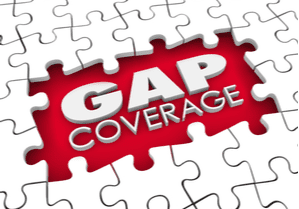By: Paul Shaheen, RHU, REBC; Vice President, Employee Benefits
If you’ve ever traveled to London and taken the underground subway (affectionately referred to as “the tube”), you’re likely long familiar with the space between the platform and the subway car itself, for which a recorded message frequently warns: “mind the gap!”
Given the sharp increases in medical coverage in 2021, the phrase has now landed on the other side of the pond.
Gap Insurance, a strategy that first took hold years ago, is now making a raging comeback. In a day and age where finding and retaining employees is an ultimate priority, employers nationwide are looking to control health insurance costs while keeping their group plans as robust as possible.
When health insurance costs rise (especially considering the overall sharp increase in claims in 2021, compared to a relatively mild year in 2020), employers frequently look to either raise employee premiums or raise deductibles and/or lower co-insurance percentages.
Simple enough, less risk imposed on carriers typically equates to lower premiums. However, that exposes employees to higher out-of-pocket costs — something employers are stridently trying to avoid right now.
Over the last few years, one strategy many groups have invoked is deductible and/or out-of-pocket reimbursement, which can be accomplished in a tax-favored manner through the mechanism of Health Reimbursement Accounts (HRA’s).
Example: To control costs, an employer moves their group medical deductible from $1,000 to $2,500. Then, upon proof of claims, they reimburse employees up to $1,500 to pick up the difference between their old and new deductible.
While relatively easy to manage (with the help of third-party administrators), the scheme does come with administrative time and costs. This essentially makes the employer a secondary insurance carrier, which can cause potential problems and issues with federal and state privacy rules by transference.
Here’s where Gap coverage comes in. At its core, Gap insurance is nothing more than a fully insured HRA, but without any of the possible pitfalls and problems.
A recent example:
- A client has a $2,500 deductible 80/20 co-insurance plan with a maximum employee out-of-pocket of $5,000 per year.
- The group takes a sizable 18% increase in premium.
- In searching for alternatives, we find a $5,000 deductible plan with a $10,000 individual maximum annual out-of-pocket.
- This plan takes the employer from an 18% increase to a five percent decrease BELOW their pre-renewal premium.
- Group installs a GAP plan that starts picking up deductible applied charges at $2,500 and then pays 100% up until $5,000 is potentially paid.
- Then, if an employee still has charges after that, they pick up the remaining $2,500, leaving their total out-of-pocket exposure at $5,000 — the same as before.
- The Gap coverage is provided by a separate insurance carrier. Employees simply present ID cards for both carriers to their medical providers, who keep this information on hand to file claims.
- Once employees have exceeded their initial $2,500 deductible, they simply file their explanations of benefits (EOB’s) from their primary carrier to their secondary carrier, which triggers the GAP plan to start paying claims.
- When adding the new group premium to the cost of the GAP coverage, the increase in monthly total premium nets out to a three percent increase. This is much more manageable for the employer, and a far cry from their initial 18% increase had the group chosen to leave the plan as is.
Note that not all Gap plans are alike. Some exclusively cover deductible and co-insurance charges, while some, for an additional cost, can also include first-dollar coverage for doctor visits and prescriptions. That said, if your plan already covers doctor visits and prescription drugs, your plan will continue to cover those first-dollar — even while the Gap plan is paying its share of an employee’s deductible and out-of-pocket.
Some are even looking at Gap plans to raise deductibles on Health Savings Account plans (HSA’s), although that can come with some complications.
No matter, Gap plans are quickly making their way back into the market as a viable alternative for employers looking to control costs while simultaneously maintaining a robust benefits plan and keeping their employees as benefit satisfied as possible.
In London, the gap can be dangerous. But with group insurance, it can be a beneficial benefit bridge.
Worth keeping in “mind.”
If you have questions or would like more information, please contact your Horton Representative.
Material posted on this website is for informational purposes only and does not constitute a legal opinion or medical advice. Contact your legal representative or medical professional for information specific to your legal or medical needs.




